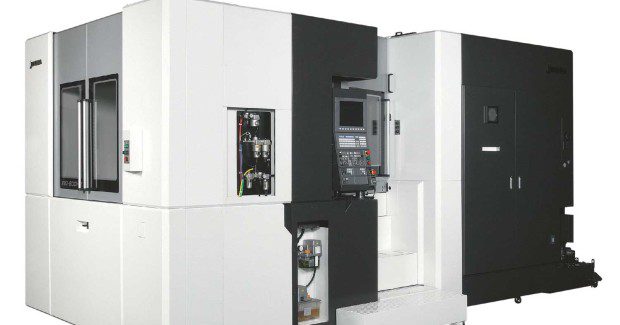The Next Step in Higher Speed Machining
The new version of the MA-600HII horizontal machining center from Okuma achieves everything from highly accurate, steady machining of mass production to long, continuous die/mold applications. From heavy-duty cutting to fine, precision work, this HMC is available with a variety of spindles to offer performance to suit a multitude of manufacturing requirements.
Posted: September 26, 2013
The next step in the evolution of machining centers – a new design for higher speed – is the new version of the MA-600HII horizontal machining center from Okuma America Corporation (Charlotte, NC), which achieves everything from highly accurate, steady machining of mass production to long, continuous die/mold applications. From heavy-duty cutting to fine, precision work, this HMC is available with a variety of spindles to offer performance to suit a multitude of manufacturing requirements.
At a high-speed axis feed of 60 m/min, this machine tool provides nearly instantaneous access to parts, improving productivity. The wide range of spindles offers full horsepower from low to high rpm. For extremely high accuracy, Okuma’s double sleeve spindle cooling system balances the spindle head temperature to prevent deformation and the resulting imperfection. The MA-600HII features high torque machining, Machining Navi, and Turn-Cut. This machine allows for upgrades to be made in the future (e.g., for increased speed.)
As machines become more complex, involving additional axes, automation and setup changing, there’s more room for human error. Many applications and development tools concentrate on the cutting and forget about the hazard of collision.
THE CAS DIFFERENCE
The optional Collision Avoidance System (CAS) on the MA-600HII integrates 3D modeling of the machine, blanks and tooling with the power of the THINC-OSP Control to create a virtual machine. By running the real-time virtual application seconds ahead of the actual cutting, problems can be detected early and the machine stopped before a costly collision.
If you’re looking for rapid metal removal, the MA-600HII horizontal machining center achieves everything from fine precision work to heavy-duty cutting. Its high torque option can generate as much as 60 hp and 790 ft-lb of torque, leading to deeper cuts at faster rates.
CAS generates the actual and exact shape of the materials milliseconds ahead of a cut to confirm that no interference takes place. Virtual Modeling requires exacting dimensions and definitions that only Okuma can deliver because we manufacture the machine and custom-create applications:
- Creates a safeguard against operator or G-code error
- Maximizes machine utilization rates via shorter setup, trial cut, and less machine down time
- Enhances productivity with shorter trial cuts that allow machinists to concentrate on machining
- Protecs the operator in manual jogging mode
- Allows the operator to run at full speed unless there’s a detected collision
THE THERMO-FRIENDLY CONCEPT DIFFERENCE
The optional Thermo-Friendly Concept combines control technology and machine design to both minimize the amount of heat generated and deal with the heat that cannot be eliminated. Coupled with extremely accurate thermal deformation compensation, the benefit is unrivaled dimensional stability over long, continuous runs. You no longer waste time and money warming machines up, thus requiring manual adjustments for temperature changes.
Machine Design — With simple machine designs and construction that equalize ambient temperatures, deformation is predictable and complex torsion or tilting is controlled.
Control Technology — Okuma’s Thermal Active Stabilizer has two components: Spindle (TAS-S) and Construction (TAS-C). TAS-S considers not only spindle temperature information but also spindle rotation, spindle speed changes, and spindle stoppage. The result is that deformation of the spindle and Z-axis are accurately controlled. TAS-C is based on machine thermal characteristics. With appropriately placed temperature sensors and feed axis position data TAS-C will predict and accurately control thermal deformation in machine construction when ambient temperatures change.
- No need for the CNC machine warm-up operation
- Eliminates manual adjustments by the operator to compensate for temperature changes
- Saves time—improves productivity
- Saves money—reduced energy usage and labor (time) costs
- Enables the machine to cut submicron-precise surfaces
- Enables durable, high-precision manufacturing
MACHINING NAVI
The optional Machining Navi chooses an optimal speed(s) at which your machine can avoid chatter, thereby saving operator time and maximizing productivity. Okuma invented Machining Navi, an optional function that uses the THINC®-OSP control and sensors to monitor chatter. If chatter is detected, the function then either recommends spindle speed changes (Machining Navi L-g and Machining Navi M-g) or automatically makes the spindle speed adjustments (Machining Navi M-i).
Machining Navi L-g — For lathe applications suppressing chatter requires a different approach, especially when turning at lower speeds. Automatic spindle variation, while maintaining safe speeds, suppresses chatter.
Machining Navi M-g — Suitable for high speed machining center applications, Machining Navi M-g uses a microphone to analyze chatter and display optimal settings for chatter-free spindle speeds.
Machining Navi M-i — Chatter vibration is measured by built-in sensors and automatically shifts rpm to the ideal speed to avoid chatter. The result is optimized cutting at the machine’s highest performance limits. The function also helps improve the ability to test new materials and cutting tools.
Okuma America Corporation, 11900 Westhall Drive, Charlotte, NC 28278, 704-588-7000, Fax: 704-588-6503, www.okuma.com.




